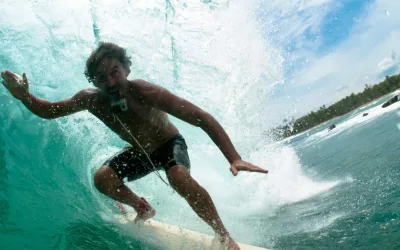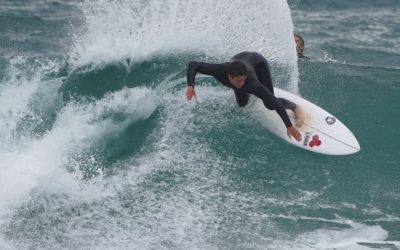Starting out in surfing is an exciting experience, but it can also be challenging. It’s normal to make mistakes at the beginning, but knowing the most common ones and how to avoid them will help you progress more quickly and enjoy each session more. At Peña Txuri Surf Eskola, our instructors identify and correct these mistakes from the start so our students can advance with confidence and safety. In this article, we show you the most common mistakes beginners make and how to overcome them.
What Are the Common Mistakes When Starting Out in Surfing?
Poor Board Choice
One of the most common mistakes is starting with a board that is not suitable for the surfer’s level. Many beginners opt for small, technical boards like shortboards, thinking they will allow them to perform advanced maneuvers from the beginning. However, this only makes learning more difficult and causes frustration.
How to Choose the Right Board?
It’s best to start with softboards, which offer more stability and buoyancy. This type of board allows you to learn the basics of surfing safely, making balance and paddling easier. At Peña Txuri Surf Eskola, we advise you on choosing the board that best suits your level and physical characteristics.
Incorrect Stance on the Board
Adopting an incorrect stance is another common mistake. This includes being too far forward or back on the board, which affects stability and makes control difficult.
What Is the Correct Stance?
The correct stance involves keeping your weight evenly distributed, with your feet well positioned over the grip marks or in the center of the board. It’s important to bend your knees and maintain a relaxed posture, always looking forward. Practicing on the shore before entering the water can help you establish this correct stance.
Not Knowing the Basic Right-of-Way Rules
Not understanding the right-of-way rules in surfing can cause conflicts with other surfers and increase the risk of accidents. It’s essential to know these rules to respect others and avoid dangerous situations.
What Right-of-Way Rules Should You Know?
- Right of Way: The surfer closest to the breaking point or peak of the wave has the priority.
- Don’t Drop In: Avoid taking off on a wave that another surfer has already caught.
- Respect the Turn: If someone has been waiting their turn, respect it and don’t go ahead of them.
At Peña Txuri Surf Eskola, we teach these rules from the first lesson to ensure respectful and safe coexistence in the water.
Poor Paddling Technique
Inefficient paddling is a common mistake that limits the ability to catch waves and tires you out quickly. Many beginners paddle with their arms too wide or too close to the board, losing strength and speed.
How to Improve Your Paddling?
- Keep Your Body Centered: Avoid lifting your chest too high and keep your abdomen close to the board.
- Efficient Paddling: Paddle with your arms slightly apart, making sure your hands enter the water at shoulder level. Perform long and controlled strokes.
Practicing paddling technique on the shore or in a pool can help you improve this aspect before facing the waves.
Attempting Advanced Maneuvers Too Soon
It’s natural to want to perform tricks and advanced maneuvers quickly, but this can lead to unnecessary falls and frustration. Before attempting complex maneuvers, it’s essential to master the basics.
Which Maneuvers Should You Master First?
- Take-off: Practice getting up on the board quickly and steadily.
- Bottom Turn: Perform basic turns after the take-off to change direction.
- Trimming: Learn to glide on the face of the wave while maintaining speed and control.
At Peña Txuri Surf Eskola, we work on these basic maneuvers until our students master them completely, ensuring they progress solidly and safely.
Not Knowing the Sea Conditions
Not paying attention to sea conditions, such as wave size, currents, and tides, is a mistake that can put your safety at risk. It’s essential to know the state of the sea before each session to avoid unpleasant surprises.
How to Evaluate the Sea Conditions?
- Wave Size and Frequency: Make sure the waves are suitable for your level. Waves that are too big can be dangerous for beginners.
- Currents: Identify the currents at the beach. Avoid entering the water in areas with strong currents or rips.
- Wind: Know how the wind affects wave shape. An offshore wind (from land to sea) improves wave quality, while an onshore wind (from sea to land) can make surfing more difficult.
In our lessons, we teach students to interpret sea conditions so they can make informed and safe decisions before entering the water.
How Do We Help Avoid These Mistakes at Peña Txuri Surf Eskola?
At Peña Txuri Surf Eskola, our instructors are trained to detect and correct these common mistakes from the start. With a personalized approach, we adapt our lessons to each student’s needs, teaching the basics clearly and effectively. This allows our students to progress quickly, avoiding bad habits and enjoying surfing with confidence and safety.
If you’re starting out in surfing and want to progress quickly and safely, book your surf lesson with us. We’ll help you improve your technique and enjoy surfing from the very first session. See you in the water!



